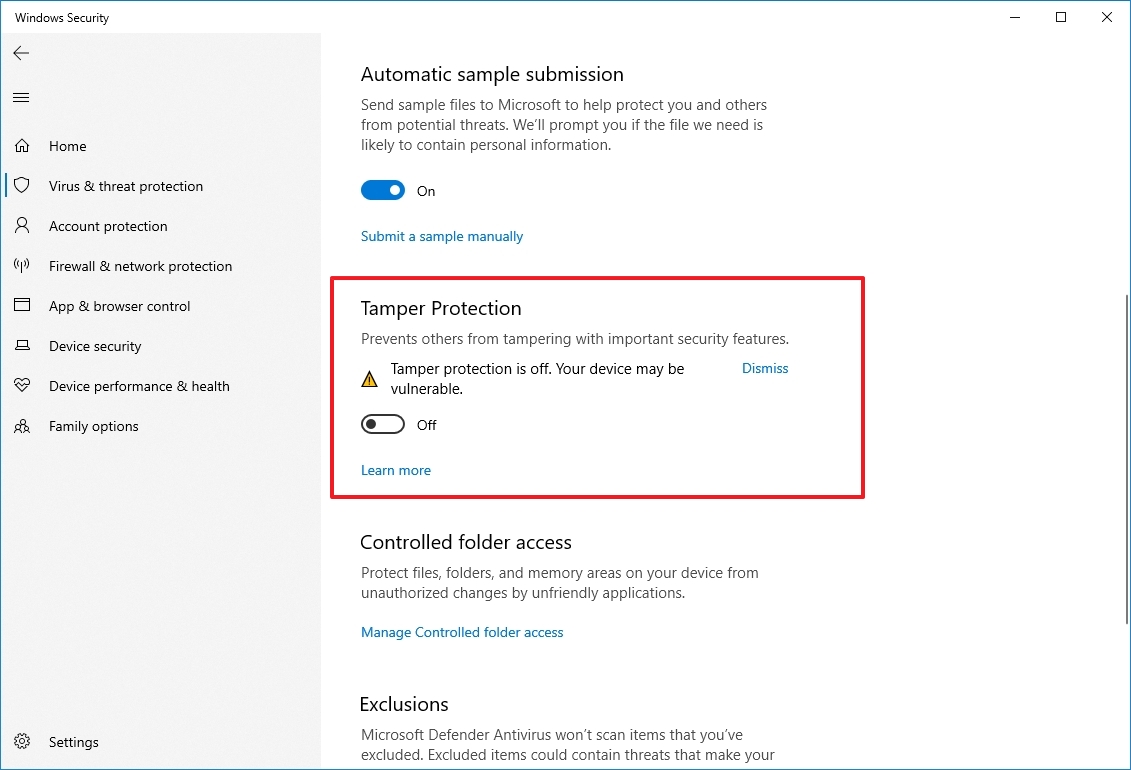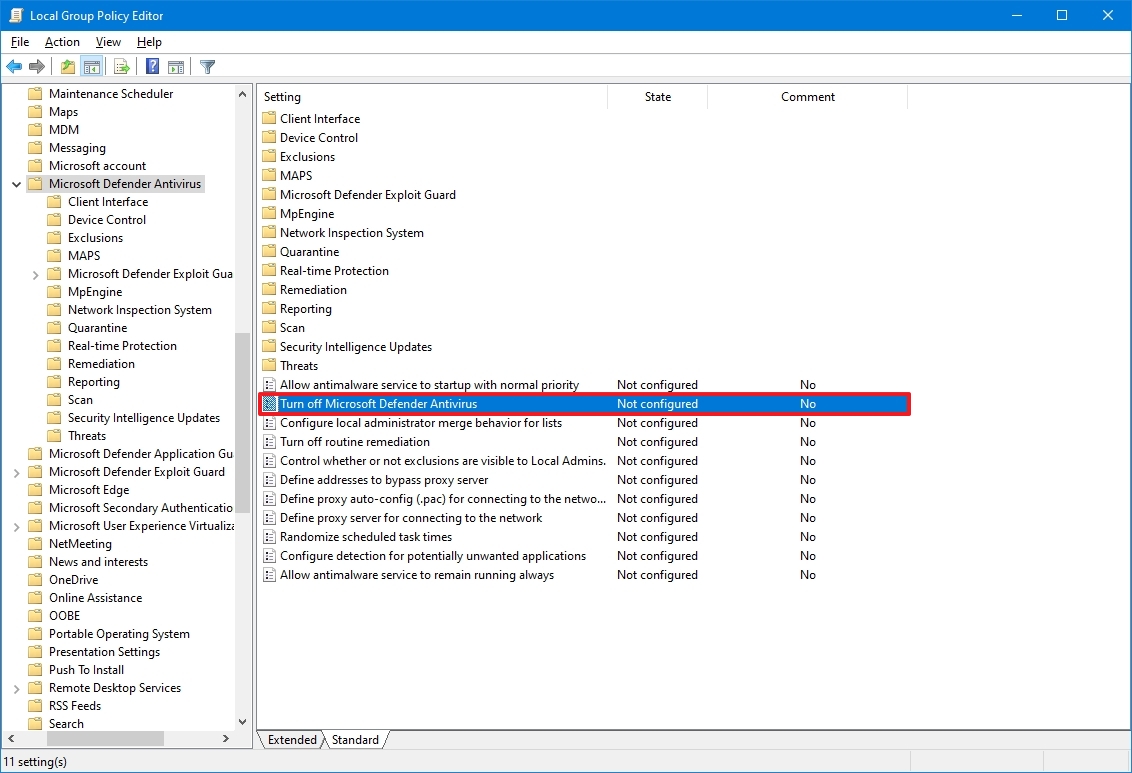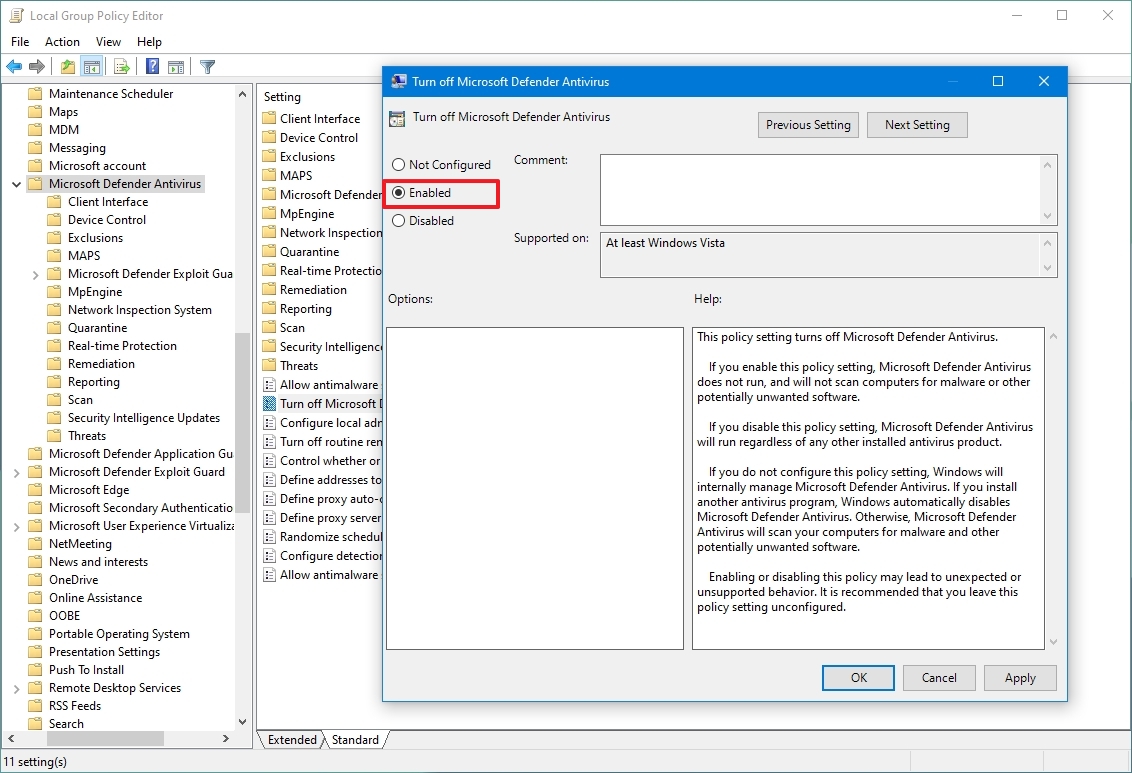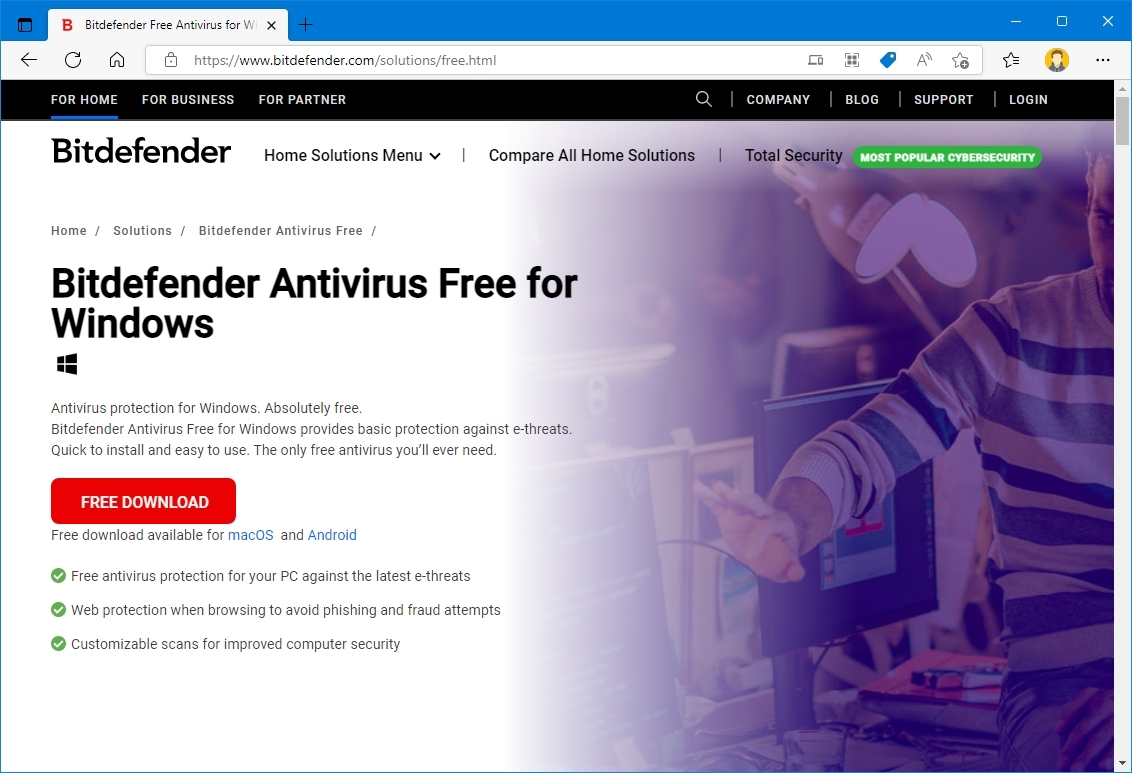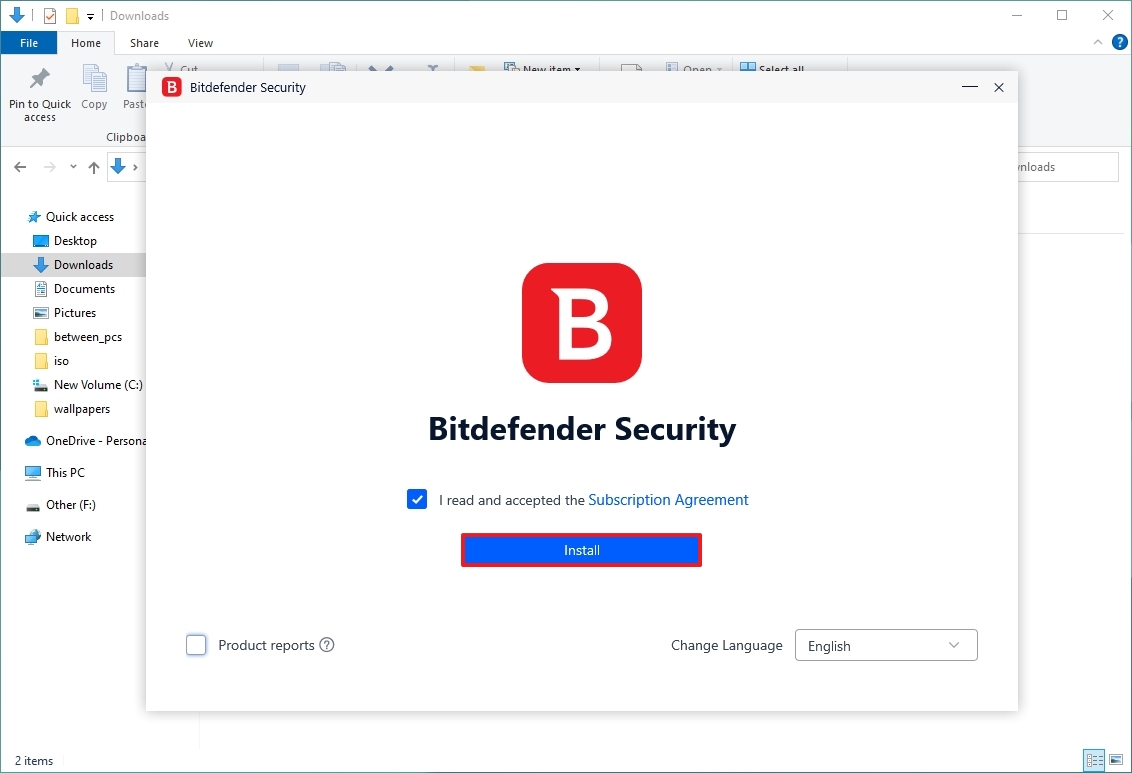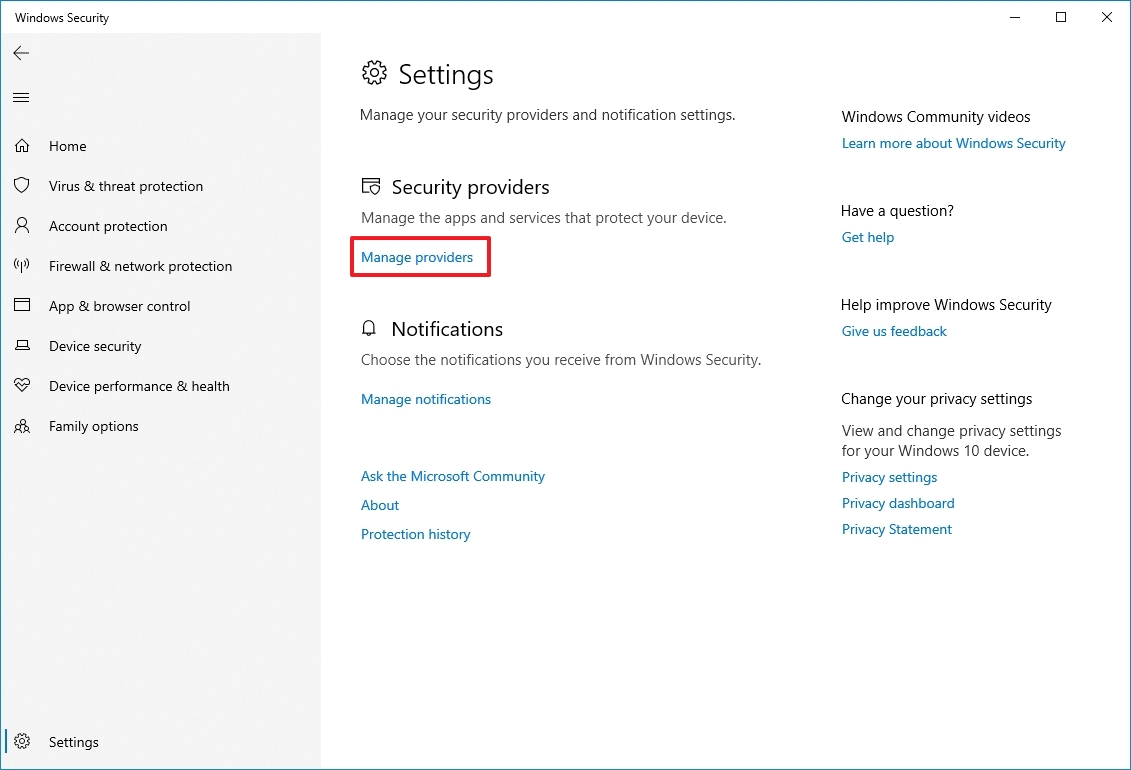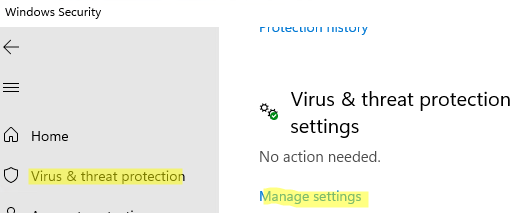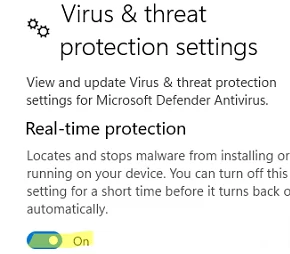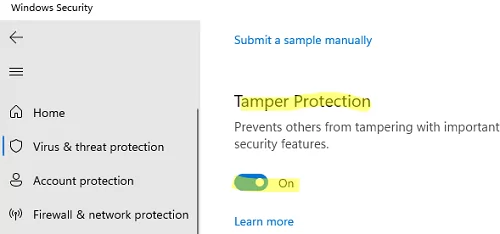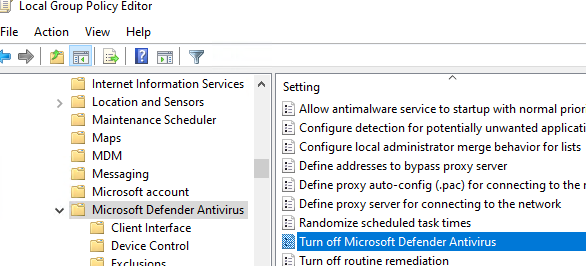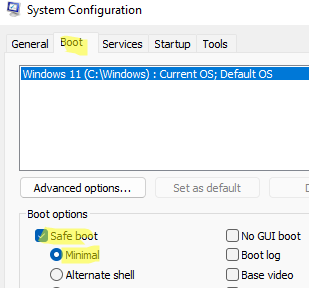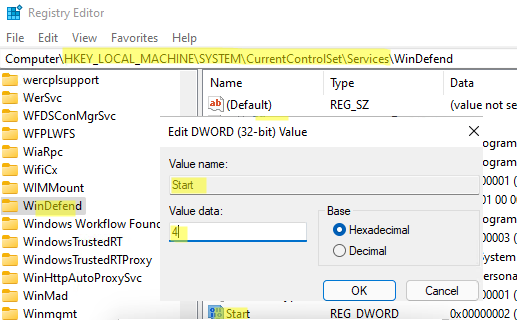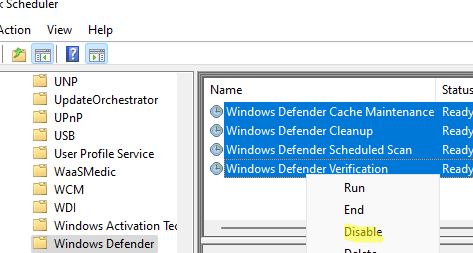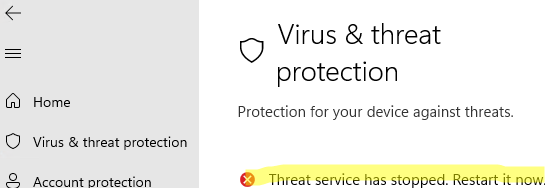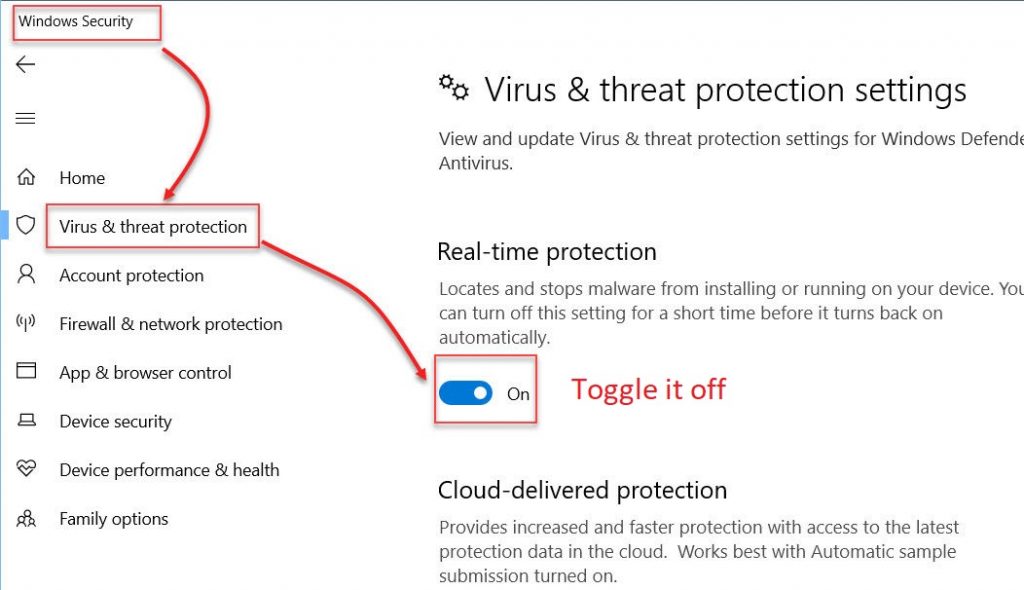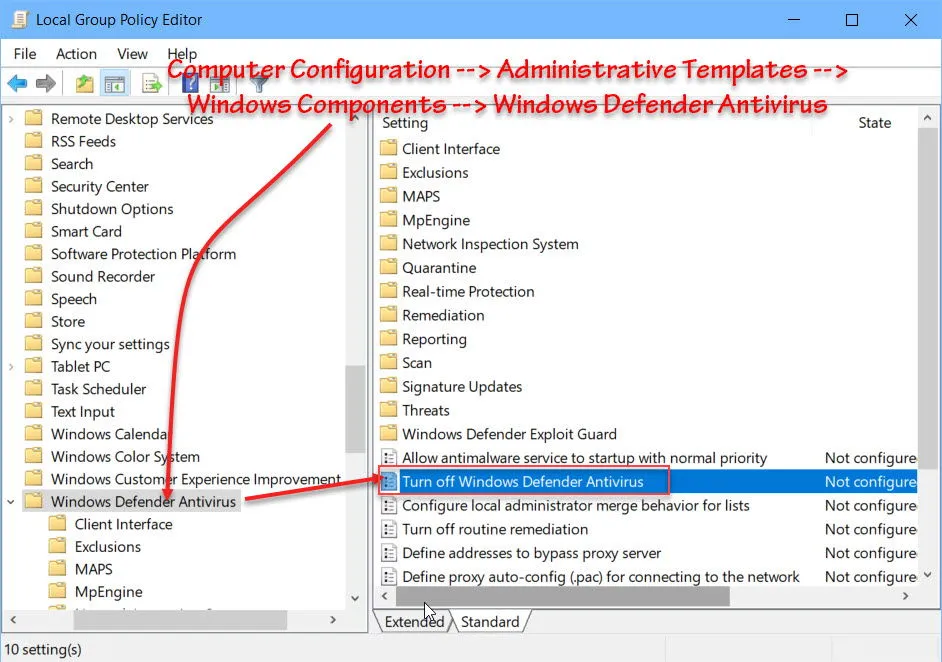
(Image credit: Future)
On Windows 10, Microsoft Defender Antivirus is the anti-malware solution that protects your computer and files from unwanted viruses, ransomware, spyware, and other malware and hackers. While it is considered one of the best computer antivirus software options, you may still find situations where you may want to disable it permanently.
For example, if you don’t like the security app for personal reasons, if you have to change system settings conflicting with the antivirus, or if you have to set up a computer that won’t connect to the network and security is not a concern. Or if you are a network administrator and must comply with the organization’s policies on some specific computers.
Although Windows 10 does not include an option to uninstall Microsoft Defender Antivirus, it is possible to permanently disable the app using Group Policy or install a third-party solution. Or you can also disable the antivirus temporarily using the Windows Security app.
This guide will walk you through the different methods to permanently disable Microsoft Defender Antivirus (or temporarily) on Windows 10.
How to disable Microsoft Defender Antivirus using Windows Security
If the antivirus conflicts with another application or installation, you don’t have to disable the Microsoft Defender Antivirus permanently. You only need to turn off the feature temporarily.
To temporarily disable the real-time antivirus protection on Windows 10, use these steps:
- Open Start.
- Search for Windows Security and click the top result to open the app.
- Click on Virus & threat protection.
- Under the «Virus & threat protection settings» section, click the Manage settings option.
- Turn off the Real-time protection toggle switch to disable Microsoft Defender Antivirus temporarily.
Once you complete the steps, the antivirus will temporarily disable its protection to install apps or make specific system changes without unwanted conflicts.
After restarting the computer, the antivirus will enable again automatically. Or you can use the same instructions outlined above, but in step 5, make sure to turn on the Real-time protection toggle switch.
This is not a permanent solution, but it’s the best option to disable the protection to make system changes or install programs that are causing conflicts.
How to disable Microsoft Defender Antivirus using Group Policy
If you want to disable Microsoft Defender Antivirus permanently, you can use the Group Policy Editor. The only caveat is that you must also disable the «Tamper Protection» feature before the policy can apply.
On Windows 10, Tamper protection is a feature that protects Windows Security against unwanted changes from outside the app. Since the Local Group Policy Editor modifies the security settings from outside the app, the antivirus will restore any changes you have made during the next restart.
Disable Tamper Protection
To disable Tamper Protection, use these steps:
- Open Start.
- Search for Windows Security and click the top result to open the app.
- Click on Virus & threat protection.
- Under the «Virus & threat protection settings» section, click the Manage settings option.
- Turn off the Tamper Protection toggle switch.
After you complete the steps, continue with the instructions to disable default Windows 10 antivirus using Group Policy.
Disable Microsoft Defender Antivirus
To disable Microsoft Defender Antivirus permanently on Windows 10, use these steps:
- Open Start.
- Search for gpedit.msc and click the top result to open the Local Group Policy Editor.
- Browse the following path: Computer Configuration > Administrative Templates > Windows Components > Microsoft Defender Antivirus
- Double-click the «Turn off Microsoft Defender Antivirus» policy.
- Select the Enabled option to disable Microsoft Defender Antivirus permanently.
- Click the Apply button.
- Click the OK button.
- Restart your computer.
Once you complete the steps, the Windows antivirus will be disabled permanently, but the «shield» icon will remain in the Taskbar because the icon is part of the Windows Security app, not the antivirus program.
You can always undo the changes using the same instructions, but in step 5, select the Not Configured option. In addition to enabling the antivirus, it is also a good idea to turn on the «Tamper Protection» feature again using the same steps outlined above, but in step 5, make sure to enable the toggle switch.
How to disable Microsoft Defender Antivirus using third-party solution
If you plan to disable the antivirus to install another anti-malware software, this process isn’t necessary since installing another security software will disable Microsoft Defender Antivirus automatically.
To disable Microsoft Defender Antivirus using third-party protection, use these steps:
- Open the antivirus download page.
- Quick note: We will be installing Bitdefender, but the instructions will be similar to any other software. Of course, it is always recommended to check the software documentation for more specific details.
- Click the Download button to save the installer on the device.
- Double-click the file to launch the installation.
- Check the option to agree to the licensing terms (if applicable).
- Click the Install button.
After you complete the steps, Windows 10 will detect the installation and automatically disable Microsoft Defender Antivirus on the computer.
Check current security provider
To check the default antivirus has been disabled, use these steps:
- Open Start.
- Search for Windows Security and click the top result to open the app.
- Click on Settings at the bottom of the page.
- Under the «Security providers» section, click the Manage providers option.
- Under the «Antivirus» section, Microsoft Defender Antivirus should appear permanently disabled.
Although multiple methods exist to disable the default antivirus on Windows 10, we do not recommend using a computer without anti-malware protection. However, some situations might still be where disabling the security feature could make sense.
If you are in the market for an alternative to Microsoft Defender Antivirus, you should consider these options:
- Bitdefender
- Norton AntiVirus Plus
More resources
For more helpful articles, coverage, and answers to common questions about Windows 10 and Windows 11, visit the following resources:
- Windows 11 on Windows Central — All you need to know
- Windows 10 on Windows Central — All you need to know
All the latest news, reviews, and guides for Windows and Xbox diehards.
Mauro Huculak is technical writer for WindowsCentral.com. His primary focus is to write comprehensive how-tos to help users get the most out of Windows 10 and its many related technologies. He has an IT background with professional certifications from Microsoft, Cisco, and CompTIA, and he’s a recognized member of the Microsoft MVP community.
Дарёному коню в зубы не смотрят, но не в нашем случае)!
В Windows 10 имеется интегрированный антивирус Windows Defender («Защитник Windows»), который выполняет функции защиты нашего компьютера и данных на нём от нежелательных программ.
Встроенное решение от Microsoft пагубно влияет на производительность системы, запускаясь вместе с ней, работает в фоновом режиме, собирая статистику о системе, и имеет привычку обновляться в «удобное» для него время. Также бывают ситуации, например, когда необходимо настроить устройство под себя или установить какой-то файл из Интернета, что, конечно же, «Защитник Windows» будет блокировать.
Тогда перед Вами станет задача отключить данную систему или вовсе искоренить из системы, но есть проблема: полностью удалить или отключить Windows Defender у Вас не выйдет – эта система глубоко интегрирована в Windows 10 и в последующие версии, начиная с 1903 version (С выходом Windows 10 May 2019 Update (версия 1903) Microsoft представила функцию «Защита от подделки», которая предотвращает изменение настроек приложения «Безопасность Windows» и антивируса Microsoft Defender вне интерфейса Windows. Под термином «настройки» здесь также учитываются инструменты командной строки, изменения реестра и групповых политик).
Однако, не спешите отчаиваться, есть несколько обходных путей, при помощи которых мы сейчас отключим антивирус Windows.
Для этого нам понадобятся 2 программы:
1) Defender Control — https://www.sordum.org/9480/defender-control-v2-1/ (официальный сайт) 2) Reg organizer — https://chemtable.ru/organizer.htm (официальный сайт)
Далее по пунктам:
1. Устанавливаем и открываем Defender Control:
2. Нас интересует 3 файл «Defender_Settings». Открываем его, нас перекидывает в «Параметры Безопасности Windows», отключаем все ползунки до самого конца страницы.
3. Далее открываем первую папку «dControl» и открываем первое приложение.
-
В открывшимся окне выбираем пункт «Отключить Защитник Windows», после чего Вы должны увидеть характерный красный цвет интерфейса.
5. Устанавливаем и открываем Reg organizer.
6. В левой панели открываем вкладку «Другие функции» и выбираем «Редактор Реестра»:
Далее просто копируете путь: HKEY_LOCAL_MACHINE\SOFTWARE\Policies\Microsoft\Windows Defender
Вы сразу попадаете в нужную папку, где необходимо правой кнопкой мыши нажать на пустое место, выбрать «Создать 32-битный целочисленный параметр (REG_DWORD)». Далее обязательно называем новый ключ DisableAntiSpyware и нажимаем «ОК».
Затем двойным щелчком откройте редактор ключа и задайте ему значение «1». Проверьте, чтобы все значения были, как на скриншоте ниже.
7. Отлично, осталось немного! Теперь чуть выше находим «Автозапуск программ», заходим в него. Выбираем Windows Security, правой кнопкой мыши выбираем пункт «Удалить и не давать появиться снова». Жмём «ОК».
Перезагружаем компьютер и радуемся отсутствию Defender-а. Победа!
Если кому-то будет полезно регулярное временное отключение, то:
Открываем PowerShell от имени Администратора и прописываем:
Set-MpPreference -DisableRealtimeMonitoring $true — чтобы выключить
Set-MpPreference -DisableRealtimeMonitoring $false — чтобы включить
Немного рекомендаций от автора: (к прочтению необязательно)
Несмотря на возможность отключения Защитника Windows, автор статьи не рекомендует использовать компьютер без антивируса вообще. Будет хорошо иметь на своём ПК антивирусное решение или хотя бы раз в месяц использовать » Полное сканирование системы». Для избежания проблем, советую обратить внимание в сторону отечественных ПО: Антивирус Kaspersky, Dr.Web и NANO Антивирус. Первые два антивируса входят в «Реестр отечественного ПО», а третий, в свою очередь, – «Единый реестр российских программ для ЭВМ и БД».
Пройдёмся кратко по каждому:
1) Dr.Web:
Российский производитель антивирусных средств защиты информации. Продукты Dr.Web разрабатываются с 1992 года. Это один из первых антивирусов в мире. Компания «Доктор Веб» — ключевой игрок на российском рынке программных средств обеспечения базовой потребности бизнеса — безопасности информации.
Стоимость: от 1209 ₽ в год (1 ПК + 1 Android)
Пробный период платной версии: 30 дней, (без техподдержки и защита только 1 ПК).
Также имеется Dr.Web CureIt! — лечащая утилита «Dr.Web CureIt!», которая не является постоянным средством для защиты компьютера от вирусов, но способна вылечить инфицированную систему однократно.
2) Kaspersky Total Security:
Стоимость: от 1709 Р в год
Пробный период платной версии: 30 дней
«Лаборатория Касперского» — международная компания, работающая в сфере информационной безопасности и цифровой приватности с 1997 года. Глубокие экспертные знания и многолетний опыт компании лежат в основе защитных решений и сервисов нового поколения, обеспечивающих безопасность бизнеса, критически важной инфраструктуры, государственных органов и рядовых пользователей. Обширное портфолио «Лаборатории Касперского» включает в себя передовые технологии для защиты конечных устройств, ряд специализированных продуктов и сервисов, а также кибериммунные решения для борьбы со сложными и постоянно эволюционирующими киберугрозами.
Помимо платных версий, имеются полностью бесплатные решения. В полностью бесплатной версии доступно:
· Помогает обеспечить безопасность устройств
Решение Kaspersky Free оснащено передовыми технологиями безопасности. Оно автоматически анализирует новые угрозы в реальном времени, помогая защищать компьютеры, мобильные устройства и планшеты, в том числе iPad.
· Бесплатный антивирус и не только
Kaspersky Free – это бесплатное антивирусное решение, которое защищает компьютеры с ОС Windows и мобильные устройства Android от вредоносного ПО, зараженных файлов, опасных приложений и подозрительных сайтов.
· Безопасность без замедления работы
Система безопасности защищает устройства, не мешая вашей работе. Kaspersky Free получает обновления автоматически, благодаря чему у вас всегда будет актуальная версия антивируса.
3) NANO Антивирус:
Стоимость: от 799 Р в год
Пробный период платной версии: 30 дней
Компания NANO Security создана в 2009 году на базе коллектива высококвалифицированных специалистов, работающих в области антивирусной безопасности с 2003 года.
Главной идеей проекта было предложить основанные на тщательно изученных предпочтениях пользователей и клиентов программные продукты, выгодно отличающиеся по ряду параметров от антивирусных решений других производителей.
Сегодня NANO Security представляет собой команду профессионалов, обладающих высокими компетенциями. В компании работают опытные эксперты в области информационной безопасности: программисты, аналитики, тестировщики и т.д.
Надеюсь, статья вышла для Вас полезной.
Далее планирую написать про хорошие антивирусные решения, которые продолжают на сегодняшний день работать/продаваться/обновляться на территории РФ.
Windows OS Hub / Windows 11 / How to Permanently Disable Microsoft Defender Antivirus on Windows 11 and 10
Microsoft Defender is the built-in antivirus program on Windows 10/11 and Windows Server that is enabled and configured by default. In this article, we’ll look at how to turn off Microsoft Defender on Windows 11 completely or suspend it.
When you install a third-party antivirus in Windows 10 or 11, the built-in Microsoft Defender Antivirus is automatically disabled. In some cases, it doesn’t happen and you may need to disable Microsoft Defender manually.
Contents:
- Turn off Defender Antivirus Protection on Windows 11 and 10
- How to Disable Microsoft Defender Antivirus in Windows 11 Permanently?
Turn off Defender Antivirus Protection on Windows 11 and 10
In some cases, you may need to suspend Microsoft Defender Antivirus protection without affecting important system services. For example, when Microsoft Defender prevents a system program or tool from running or installing. To run such an app, you have to stop Windows Defender Real-time Protection.
- Open Settings -> Privacy and Security -> Windows Security (or run a quick access URI command:
ms-settings:windowsdefender) in Windows 11; - Open Virus and threat protection and click Manage Settings;
- Move the Real-time protection toggle to Off.
- Confirm that you want to stop antivirus protection in the UAC prompt.
To resume Windows Defender protection, move the toggle to On. Also, Microsoft Defender Real-time Protection is enabled automatically after you restart the computer.
You can use the following PowerShell command to disable real-time protection (see how to manage Windows Defender settings using PowerShell):
Set-MpPreference -DisableRealtimeMonitoring $true
However, this command doesn’t work as expected in Windows 11 and the latest Windows 10 builds. The matter is that in Windows 10 1903 or later, a new Microsoft Defender feature is enabled by default: Microsoft Defender Tamper Protection.
Tamper protection provides additional protection for core Microsoft Defender security features. In particular, it prevents unauthorized changes of antivirus settings, suspension of real-time protection, and disabling of cloud protection. If the Tamper Protection is enabled, you won’t be able to disable Real-Time Protection in Microsoft Defender using PowerShell.
You can only disable Tamper Protection manually from Windows Security GUI. Navigate to Virus and threat protection section, scroll down and switch the Tamper Protection toggle to Off.
After disabling Tamper Protection, you will be able to disable Microsoft Defender Real-time Protection using the PowerShell command shown above.
How to Disable Microsoft Defender Antivirus in Windows 11 Permanently?
In earlier Windows 10 builds and in Windows Server 2016, you could completely disable Windows Defender using the Turn off Windows Defender Antivirus GPO option located in Computer Configurations -> Administrative Template -> Windows Component -> Windows Defender Antivirus section of the Local Group Policy Editor (gpedit.msc) or using the DisableAntiSpyware registry parameter under HKEY_LOCAL_MACHINE\SOFTWARE\Policies\Microsoft\Windows Defender:
New-ItemProperty -Path “HKLM:\SOFTWARE\Policies\Microsoft\Windows Defender” -Name DisableAntiSpyware -Value 1 -PropertyType DWORD -Force
Also, you can disable Real-Time Protection using the GPO option Turn on behavior monitoring or with the registry parameter DisableBehaviorMonitoring =1.
Starting from Windows 10 1903 release, you cannot use these GPO options or registry parameters to disable Microsoft Defender, because these settings are shielded by Tamper Protection. The methods previously used to disable Microsoft Defender Antivirus don’t work on Windows 11.
To completely disable Windows Defender Antivirus on Windows 11, you need to boot your computer to Safe Mode.
- Run
msconfig; - Go to the Boot tab;
- Select Safe boot -> Minimal in the boot options section;
- Click OK and restart your computer.
- Your computer will boot into Safe Mode;
- Then open the Registry Editor (
regedit.exe), go to the reg key HKEY_LOCAL_MACHINE\SYSTEM\CurrentControlSet\Services and disable the startup of the following services:- Sense
- WdBoot
- WdFilter
- WdNisDrv
- WdNisSvc
- WinDefend
To do it, change the Start parameter value to 4.
Change the Start value for all services specified above manually or using the following PowerShell script:
$regpath='HKLM:\SYSTEM\CurrentControlSet\Services'
Set-ItemProperty -Path ($regpath+"\WinDefend") -Name Start -Value 4
Set-ItemProperty -Path ($regpath+"\Sense") -Name Start -Value 4
Set-ItemProperty -Path ($regpath+"\WdFilter") -Name Start -Value 4
Set-ItemProperty -Path ($regpath+"\WdNisDrv") -Name Start -Value 4
Set-ItemProperty -Path ($regpath+"\WdNisSvc”) -Name Start -Value 4
Set-ItemProperty -Path ($regpath+"\WdBoot") -Name Start -Value 4
To re-enable Microsoft Defender in Windows, set the following default values of the Start registry entry for services:
- Sense — 3
- WdBoot — 0
- WdFilter — 0
- WdNisDrv — 3
- WdNisSvc — 3
- WinDefend — 2
- Run msconfig and disable the Safe Mode. Then restart your computer and boot as usual;
- Disable the following four tasks in Task Scheduler (
taskschd.msc): Microsoft –> Windows –> Windows Defender.
Get-ScheduledTask “Windows Defender Cache Maintenance” | Disable-ScheduledTask
Get-ScheduledTask “Windows Defender Cleanup” | Disable-ScheduledTask
Get-ScheduledTask “Windows Defender Scheduled Scan” | Disable-ScheduledTask
Get-ScheduledTask “Windows Defender Verification” | Disable-ScheduledTask
Run the Windows Security app and make sure that Microsoft Defender Antivirus is now disabled. You should see the message: Threat service has stopped. Restart it now.
So we have looked at how to disable Microsoft Defender Antivirus on Windows 10 and 11.
Why should I turn Windows Defender off?
In general, if you want to make sure your PC is safe, you should always have security turned on. This could be done by using Windows Defender, which is built into Windows 10 by Microsoft, or by using a security tool from a company other than Microsoft.
You may need to turn off Windows’ antivirus and firewall protections at times. For example, when you are playing a game but the antivirus keeps scanning the files, which slows down the system. Another example is when your antivirus finds a program as a false positive, even though you know it’s safe to use.
Some people think it’s safe to turn off Windows Defender and use software that can break security. This includes using illegal tools like KMSPico or the Microsoft Toolkit to activate Windows. These tools for cracking are not safe in any way. They might put malware into the system that the antivirus might not be able to find after it is installed. The malware is used to hack and mine for cryptocurrency.
Windows Defender can be turned off either temporarily or permanently. We will talk about both here.
1. How to use Windows Settings to turn off Windows Defender
Follow these steps to turn Windows Defender on or off using Windows Settings:
- Open Windows Settings (Windows key + i)
- Go to Update & Security –> Windows Security
- From the right-hand pane, select Manage settings under Virus & threat protection settings.
- Toggle the switch to Off under Real-time protection.
When you do this, automatic protection will be off, but you may still run a scan manually.
2. Turn off Windows Defender quickly with Defender Control
See details and download Defender Control here
3. How To Permanently Turn Off Windows Defender Using Group Policy
If you are in charge of a network and want to get rid of Windows Defender from it, you should use Group Policy. Just follow the steps below to use the Group Policy editor to turn off Windows Defender:
- Open Group Policy Editor (Run –> gpedit.msc)
- Go to Computer Configuration –> Administrative Templates –> Windows Components –> Windows Defender Antivirus
3. Open Turn off Windows Defender Antivirus from the right-hand pane and choose Enabled.
Both Local Group Policy and Domain Group Policy can be used to change this setting. Windows Defender will be turned off for all local users by the local policy, while it will be turned off for all systems where the domain policy is applied by the domain policy.
4. How To Permanently Disable Windows Defender Using Windows Registry
By adding or changing a few registry keys, you may also permanently disable Windows Defender via the Windows Registry. The steps are as follows:
- Go to Run –> regedit. This will open the Windows Registry Editor.
- Navigate to the following key:
HKEY_LOCAL_MACHINE\SOFTWARE\Policies\Microsoft\Windows Defender - In the right pane, right-click the empty area and create a new DWORD (32-bit) value.
- Rename the new item to DisableAntiSpyware
- Double-click DisableAntiSpyware and change its value to 1.
After the next restart, Windows Defender will not load. To turn Windows Defender back on, you can either delete the key you made or change its value to 0.
Please keep in mind that you can’t get rid of Windows Defender completely. Even if you delete its service or files, it will probably come back with the next big Windows update.
There are a few times when a user might want to turn off a certain part of Windows Defender. We will talk about the following situations.
5. How to turn off Windows Firewall only
To disable the Windows Firewall while still using other Windows Defender features, follow the instructions below:
- Open Windows Settings (Windows key + i)
- Click on Update & Security and then Windows Security
- In the right-hand pane, click on Open Windows Security
- From the left-hand pane, select Firewall & network protection
- In the right-hand pane, you will see three protection types. Domain network, Private network, Public network.
- Click on each network type and toggle it to disabled.
Only the firewall will be turned off. Windows Defender’s antivirus and other features will continue to work.
6. How to turn off Windows Defender real-time antivirus only
If you only want to turn off the real-time protection, you can do so by following these steps:
- Open Windows Settings (Windows key + i)
- Click on Update & Security and then Windows Security
- From the left-hand pane, click on Virus & threat protection
- In the right-hand pane, toggle real-time protection to off.
When using Windows, you’ll notice that it comes with its own antivirus called Windows Defender (now called Windows Security and Microsoft Defender in later versions of Windows 10 and Windows 11). For some, Windows Defender is more of a hindrance than a help, and they’ll want to disable Windows Defender completely. As you’ll discover in this tutorial, disabling Windows Defender isn’t as easy as it should be. Regardless, making sure Defender goes down and stays down isn’t very tricky at all.
Content
- Why Not Use the Default Option?
- Disable Windows Defender Permanently
- Using the Registry (Available for ALL Users)
- Using Local Group Policy
- Use a Third-Party Antivirus
- Disable Periodic Scanning
- Disable Windows Defender Tasks
- Frequently Asked Questions
Why Not Use the Default Option?
It may seem a little confusing that turning off Windows Defender permanently is trickier than it should be. After all, there’s an option within Windows to disable Defender.
- You can access it by going to «Start -> Settings -> Privacy & security.»

- Select «Windows Security» or «Windows Defender,» depending on your version of Windows.
- In Windows 10, you’ll see an option to turn Defender off under «Real-time protection.» However, if you read the description of the setting, you’ll spot the problem. Windows Defender will only stay inactive for a short period of time. When it detects that it’s been off for too long, it will automatically turn itself back on again. If you want Windows Defender to stay disabled, you’ll have to keep toggling this option off every time Windows resets it. What a hassle!

- If you’re using Windows 11, the same settings exist, but you have to go through a few extra screens. Click on «Open Windows Security.»

- Select «Virus & threat protection.»

- Scroll until you see «Virus & threat protection settings.» Click the «Manage Settings» link.

- Toggle the various options to «Off,» just like you would in Windows 10. It’s a pain trying to get to the settings, but once you do, they’ll look similar to Windows 10.

Also, just as in Windows 10, turning everything off is just temporary. This is great if you just need to turn Windows Defender off for a short while but doesn’t solve the ultimate goal of turning off Windows Defender permanently.
Note: if you’re already using another antivirus instead of Windows Defender, you may not see these settings at all – which is a fix in itself and will be detailed below.
Fortunately, there are ways to make it so that Windows Defender doesn’t reenable itself. Keep in mind that you’ll have to make sure you do not browse the Web without a functioning antivirus active! You need to have something installed beforehand to make up for Windows Defender being turned off.
You have a few options when it comes to disabling Windows Defender.
- The first is the simplest: just install a third-party virus program on your PC to disable the Defender in part.
- For a more permanent solution, you can go through the registry or Local Group Policy window. Typically, the Local Group Policy solution is a little easier to perform, but you can only use it on Pro, Enterprise, and Education editions of Windows 10 and 11.
If you don’t use any of the above editions, or aren’t sure which one you’re using, don’t worry! All versions of Windows 10 and Windows 11 can turn off Windows Defender using the registry method. Just follow the steps below, and you should have your problem fixed in no time.
Before you proceed with registry options, you have to disable Windows Defender Tamper Protection. This is a great feature that helps prevent another user or even a virus from disabling your built-in antivirus. Otherwise, any changes you make in the following sections will go away once you restart.
- Go to «Start -> Settings -> Privacy & security -> Windows Security.»
- Select «Virus & threat protection.» If you don’t see this option, select «Open Windows Security,» then select «Virus & threat protection.»

- Select «Manage Settings.»

- Toggle off «Tamper Protection.»

Using the Registry (Available for ALL Users)
- Open the Run command by pressing Win + R. In the box that appears, type
regeditand click «OK.»

Note: Make a backup of your registry before you make any changes. You can do this by opening the Registry Editor, then «File -> Export.» Place the copy in a safe place. If you want to clean up your registry from time to time, learn how to defragment it.
- The system registry will open. On the left, navigate to the following folder:
HKEY_LOCAL_MACHINE\SOFTWARE\Policies\Microsoft\Windows Defender
- You may see a folder after Windows Defender called «Policy Manager.» Don’t click on it. Instead, select the Windows Defender folder as shown in the following image.

- On the right side of the window, you may see a file called «DisableAntiSpyware.» If you do, that’s great! If not, we’re going to have to make our own. To do this, right-click in the empty space on the right side of the window and go to «New -> DWORD (32-bit) Value.»

- Windows will create an untitled DWORD file. Right-click the file and click «Rename,» then call it «DisableAntiSpyware.» Make sure you enter the name perfectly!
- Right-click the «DisableAntiSpyware» file and click «Modify.»

- To enable the policy that disables Windows Defender, set the value data to «1» and click «OK.» This tells the computer that the policy that was just created should be enabled, and Windows will disable Defender for you. If you ever want to bring Windows Defender back, just return to this file and change the value to «0.» This disables the policy and allows Windows Defender to work again.

- The next time you try to load Windows Defender, you’ll see the following error message saying it’s been turned off.

If anything related to Defender is still running, add the following DWORD values in the following folder locations using the same process as above:
- DisableRealtimeMonitoring – set the value to 1.
- DisableRoutinelyTakingAction – set the value to 1.
- DisableAntiVirus – set the value to 1.
- DisableSpecialRunningModes – set the value to 1.
- ServiceKeepAlive – set value to 0.
You may also need to create three new folders under Windows Defender. Right-click the «Windows Defender» folder and select «New -> Key.» Add three new Keys: «Signature Updates,» «Real-Time Protection,» and «Spynet.»
Next, add the following DWORD values to the corresponding folders:
HKEY_LOCAL_MACHINE\SOFTWARE\Policies\Microsoft\Windows Defender\Signature Updates
- ForceUpdateFromMU – set value to 0.
HKEY_LOCAL_MACHINE\SOFTWARE\Policies\Microsoft\Windows Defender\Real-Time Protection
- DisableRealtimeMonitoring – set value to 1.
- DisableOnAccessProtection – set value to 1.
- DisableBehaviorMonitoring – set value to 1.
- DisableScanOnRealtimeEnable (Set value to 1)
HKEY_LOCAL_MACHINE\SOFTWARE\Policies\Microsoft\Windows Defender\Spynet
- DisableBlockAtFirstSeen – set value to 1.
Tip: if you’re having trouble opening Windows Security on your PC, here are some fixes.
Using Local Group Policy
- Press Win + R to load the Run box, then type
gpedit.mscinto the box and press «OK.»

- If you attempt to run it in a different edition, such as Home, you’ll get the following error. This means you cannot use this method to disable Windows Defender. In this case, you’ll want to use one of the other two remaining methods outlined in this article.

- When the Local Group Policy window loads, select «Computer Configuration -> Administrative Templates» on the right.
- Go to «Windows Components -> Windows Defender (Antivirus).» Scroll down until you see a file called «Turn off Windows Defender.»

- Double-click it and click «Enabled» on the left. This turns on the «Turn off Windows Defender» policy, which disables Windows Defender. If you change your mind in the future, you can come back and select «Disabled» instead.

Use a Third-Party Antivirus
You’re not under any obligation to use what Windows comes with. While it does work surprisingly well, you can use any third-party antivirus. This is also an easy way to permanently disable Windows Defender.
- Download and install the antivirus of your choice. We have several recommendations along with advice on using a third-party antivirus with Windows 11.
- Once installed, Windows Defender should go into passive mode, which means it’s no longer running. If your antivirus doesn’t have a firewall, the Windows Defender firewall will still run.
- Check that your system is using the correct antivirus by going to «Start -> Settings -> Privacy & Security -> Windows Security.»
- Select either «Virus & threat protection» or «Open Windows Security.» If you choose the latter, you’ll need to select «Virus & threat protection» on that page.

- Select «Manage providers.» Depending on your version of Windows, this may be listed in the center of the window or to the far right.

- Check that your third-party antivirus is turned on and that Microsoft Defender Antivirus is turned off. If it’s the other way around, select your antivirus and turn it on, then turn off Defender.

- If you have another firewall installed, you’ll also be able to change your firewall preferences under the «Firewall & network protection» section. Otherwise, the Microsoft Firewall will stay on.
Windows Defender issues might cause you to get a «This setting is managed by your administrator» error. Fortunately, we can help you solve it.
Disable Periodic Scanning
Even if you’ve installed another antivirus, Windows may still run periodic scans. These won’t run at the same time as your third-party antivirus, but if you want to fully disable Windows Defender, you’ll want to stop these extra scans. By default, Windows 11 turns periodic scans off when installing another antivirus, but Windows 10 doesn’t always do this.
- Go to «Start -> Settings -> Privacy & security -> Windows Security.»
- Open «Virus & threat protection.» If this isn’t an option, select «Open Windows Security» first.
- Expand «Microsoft Defender Options.»

- Turn off «Periodic scanning.»
Disable Windows Defender Tasks
If Windows Defender is still trying to run, you may need to manually disable a few tasks and services.
- Click the Start menu and search for «task scheduler.» Select «Task Scheduler.»

- In the left pane, open «Task Scheduler Library -> Microsoft -> Windows -> Windows Defender.»

- If you see any tasks listed here, right-click each one and choose «Disable.»
- As a final step, you may also need to disable one or more Windows Defender services. This is especially true if you’re having trouble turning off the built-in firewall and want to use something else. Press Win + R, type
services.mscand click «OK.»

- Look for both «Microsoft Defender» and «Windows Defender.» We had the following services listed: Microsoft Defender Antivirus, Microsoft Defender Antivirus Network Inspection Service, and Windows Defender Firewall.
- If the services are listed as «Manual» or «Disabled» under «Startup Type» and aren’t listed as «Running,» you don’t need to worry about it. If it’s running or listed as «Automatic,» right-click the service and select «Properties.»

- Stop the service if it’s running and change the «Startup type» to «Manual» or «Disabled.»

- Press «Apply» to confirm the changes. You may be prompted to restart your computer after disabling tasks and services.
Ever wondered if your antivirus is working properly? Learn how to test your program against real malware to get the answer.
Frequently Asked Questions
Is it safe to permanently disable Windows Defender?
Yes. However, you should immediately turn on another antivirus program. Windows Defender is designed to protect you from the moment you start using Windows, but you don’t have to use it if you don’t want to. That’s why it’s a good idea to leave it running until you’re ready to install something else. Even if you’re extremely careful, odds are that you’ll encounter a virus at some point. Blocking it is much easier than trying to remove it. While you can remove it without an antivirus, it’s not easy.
Can Windows Defender cause my PC to run slowly?
Unless you’re running a full scan, you shouldn’t notice any real interference. In fact, Windows Defender uses fewer system resources than most antivirus apps. If your PC is running slowly, check Task Manager (Win + X and select «Task Manager») to see what’s running and using the most resources. It could actually be a sign of a virus infection that got past Windows Defender or another antivirus app you have installed.
Is it safe to run Windows Defender with another antivirus app?
Yes, but you can only use the firewall and periodic scans in Windows Defender while another antivirus is active. Consider Defender a backup antivirus. Or, if something happens to your third-party antivirus, Windows Defender will immediately take over until you resolve any issues with your other antivirus.
Why is Windows Defender coming back on after every restart?
Ensure you turned off Tamper Protection in the Windows Defender settings. Outside of installing a third-party antivirus, anything you do to disable Windows Defender will go away after a restart if Tamper Protection is left on. It’s also possible you don’t have admin privileges to change these settings.
Image credit: Unsplash. All screenshots by Crystal Crowder.
Crystal Crowder has spent over 15 years working in the tech industry, first as an IT technician and then as a writer. She works to help teach others how to get the most from their devices, systems, and apps. She stays on top of the latest trends and is always finding solutions to common tech problems.
Subscribe to our newsletter!
Our latest tutorials delivered straight to your inbox


